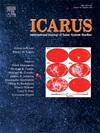How does topography affect wind abrasion on Mars? Recently observed shifts in ventifact orientation at Gale crater
IF 3
2区 物理与天体物理
Q2 ASTRONOMY & ASTROPHYSICS
引用次数: 0
Abstract
Wind abrasion is the dominant erosive process inferred from observations by Curiosity during its traverse in Gale crater, but how and how fast wind scours Mount Sharp is unclear. Here, we infer formative wind direction from ventifacts (wind-eroded rock fragments) measured from Curiosity's recent traverse. We compare these measurements to previous ones and to wind model predictions, and attempt to estimate the current rate of wind erosion near Curiosity's location on Mount Sharp. Ventifacts in this study indicate winds blowing south-southeast, agreeing with previous studies on the floor of Gale crater, but differing from studies at the base of the mountain slope. Upslope abrasive wind flows predominate, consistent with idealized models. At some sites, ventifacts are oriented both upslope and downslope on Mount Sharp, suggesting bimodal wind direction at the mountain, agreeing with circulation models that predict diurnal reversals. Using crater-retention age statistics at one site, we estimate a ∼ 3.5 ± 0.8 μm/Earth year (yr) upslope horizontal erosion rate at Mount Sharp. We suggest the observed ventifacts formed when Mars' obliquity and climate regime were similar to those in the present day.
地形如何影响火星上的风蚀?最近在盖尔陨石坑观测到气流方向的变化
从好奇号穿越盖尔陨石坑时的观测推断,风磨损是主要的侵蚀过程,但风冲刷夏普山的方式和速度尚不清楚。在这里,我们从好奇号最近的穿越中测量到的风蚀岩石碎片来推断形成的风向。我们将这些测量结果与之前的测量结果以及风模型预测结果进行比较,并试图估计好奇号位于夏普山附近的风蚀率。这项研究中的通风机表明风向是东南偏南的,这与之前在盖尔陨石坑底部的研究一致,但与在山坡底部的研究不同。上坡磨蚀气流占主导地位,与理想模型一致。在一些地点,夏普山的通风设备既面向上坡,也面向下坡,这表明山上的风向是双峰的,与预测日反转的环流模式一致。利用一个地点的陨石坑保留年龄统计,我们估计夏普山的上坡水平侵蚀速率为~ 3.5±0.8 μm/地球年(yr)。我们认为,观测到的通风口形成于火星的倾角和气候状况与今天相似的时期。
本文章由计算机程序翻译,如有差异,请以英文原文为准。
求助全文
约1分钟内获得全文
求助全文
来源期刊

Icarus
地学天文-天文与天体物理
CiteScore
6.30
自引率
18.80%
发文量
356
审稿时长
2-4 weeks
期刊介绍:
Icarus is devoted to the publication of original contributions in the field of Solar System studies. Manuscripts reporting the results of new research - observational, experimental, or theoretical - concerning the astronomy, geology, meteorology, physics, chemistry, biology, and other scientific aspects of our Solar System or extrasolar systems are welcome. The journal generally does not publish papers devoted exclusively to the Sun, the Earth, celestial mechanics, meteoritics, or astrophysics. Icarus does not publish papers that provide "improved" versions of Bode''s law, or other numerical relations, without a sound physical basis. Icarus does not publish meeting announcements or general notices. Reviews, historical papers, and manuscripts describing spacecraft instrumentation may be considered, but only with prior approval of the editor. An entire issue of the journal is occasionally devoted to a single subject, usually arising from a conference on the same topic. The language of publication is English. American or British usage is accepted, but not a mixture of these.
 求助内容:
求助内容: 应助结果提醒方式:
应助结果提醒方式:


